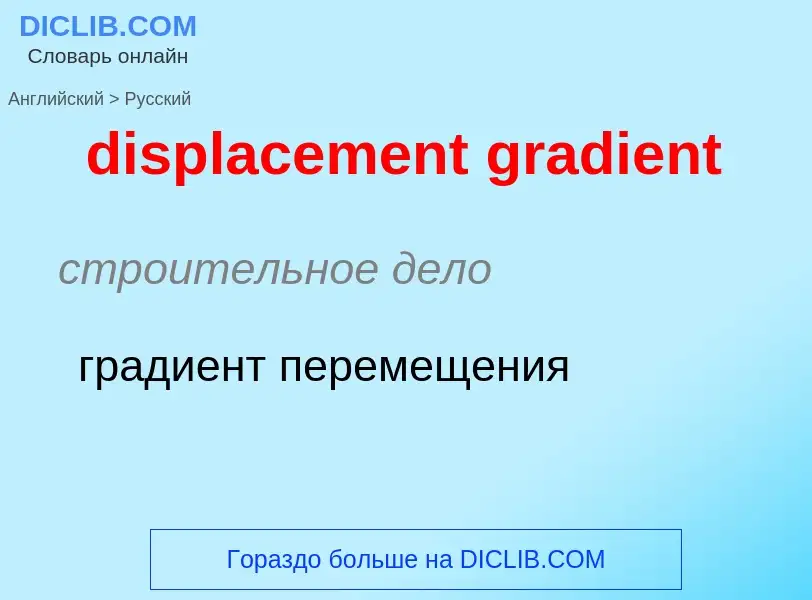Перевод и анализ слов искусственным интеллектом ChatGPT
На этой странице Вы можете получить подробный анализ слова или словосочетания, произведенный с помощью лучшей на сегодняшний день технологии искусственного интеллекта:
- как употребляется слово
- частота употребления
- используется оно чаще в устной или письменной речи
- варианты перевода слова
- примеры употребления (несколько фраз с переводом)
- этимология
displacement gradient - перевод на русский
строительное дело
градиент перемещения
общая лексика
нормальное водоизмещение
общая лексика
весовое водоизмещение
общая лексика
водоизмещение порожнем
нефтегазовая промышленность
водоизмещение (плавучего бурового основания) с установленным оборудованием (без топлива, балласта, предметов снабжения, бурильных труб, бригады)
['greidiənt]
общая лексика
градиент
плавно меняющийся (по насыщенности) цвет, плавный переход одного цвета в другой
градиентный цвет, градиентная закраска
градиентный
наклон
падение
уклон
профессионализм
раскат тонов, градиент
строительное дело
участок дороги на уклоне, продольный уклон (дороги)
заложение (откоса насыпи)
прилагательное
общая лексика
движущийся
шагающий
передвигающийся
обладающий способностью двигаться
равномерно повышающийся или понижающийся
геральдика
изображённый шагающим
существительное
['greidiənt]
общая лексика
уклон, скат
склонение (стрелки барометра)
математика
градиент
наклон
специальный термин
уклон
добыча полезных ископаемых
скат
бремсберг
метеорология
склонение (стрелки барометра)
общая лексика
полная нагрузка
нефтегазовая промышленность
полный заряд
Определение
Википедия
In geometry and mechanics, a displacement is a vector whose length is the shortest distance from the initial to the final position of a point P undergoing motion. It quantifies both the distance and direction of the net or total motion along a straight line from the initial position to the final position of the point trajectory. A displacement may be identified with the translation that maps the initial position to the final position.
A displacement may be also described as a relative position (resulting from the motion), that is, as the final position xf of a point relative to its initial position xi. The corresponding displacement vector can be defined as the difference between the final and initial positions:
In considering motions of objects over time, the instantaneous velocity of the object is the rate of change of the displacement as a function of time. The instantaneous speed, then, is distinct from velocity, or the time rate of change of the distance travelled along a specific path. The velocity may be equivalently defined as the time rate of change of the position vector. If one considers a moving initial position, or equivalently a moving origin (e.g. an initial position or origin which is fixed to a train wagon, which in turn moves on its rail track), the velocity of P (e.g. a point representing the position of a passenger walking on the train) may be referred to as a relative velocity, as opposed to an absolute velocity, which is computed with respect to a point which is considered to be 'fixed in space' (such as, for instance, a point fixed on the floor of the train station).
For motion over a given interval of time, the displacement divided by the length of the time interval defines the average velocity, which is a vector, and differs thus from the average speed, which is a scalar quantity.

.jpg?width=200)
![USS ''Abel P. Upshur'']] are destroyers of comparable size, but because the latter is more heavily loaded, it sits lower, displacing more water. USS ''Abel P. Upshur'']] are destroyers of comparable size, but because the latter is more heavily loaded, it sits lower, displacing more water.](https://commons.wikimedia.org/wiki/Special:FilePath/The Arrival of the First Flotilla of Destroyers From America To the Royal Navy, Devonport, September 1940 A724.jpg?width=200)

![displacement]] displacement]]](https://commons.wikimedia.org/wiki/Special:FilePath/Archimedes bath.jpg?width=200)
